edward mallandaine + mary ann martha leigh boyles
Edward was born in Singapore on 10 August 1827 while his father, John West Mallandaine, was in command the 35th Madras Native Infantry stationed there. Edward’s father had served in the East India Company Army for twenty five years and spent most of this time in southern India.
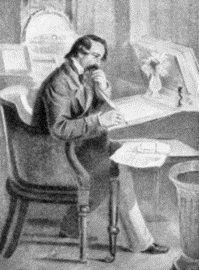
Edward’s early years were filled with change as circumstances took his family from India to England and then on to France. The family returned to India from Singapore in 1829 and three years later, Edward’s mother, Mary Smith, died of Asiatic Cholera in Hassan. Following his mother’s death, five year old Edward left India and returned to England with his father and three sisters. They stayed with their grandparents in Stepney but several months later, Edward’s father remarried and moved his young family to Hildenborough in Kent. Their stay in England was short lived as only three years later, the family relocated to France.
Edward’s Aunt Mary accompanied the family to Kent and acted as governess and teacher to her nieces and nephew. Edward continued his studies in France and had what can best be described as a classical education studying drawing, painting, music and dance. In his memoirs, Edward recalls his childhood in France with fondness but it seems that his relationship with his father was always a difficult one.
Before I left the paternal roof in my 17th year…8 olive branches had already been added to the family nursery. I had for some time, been kept at school simply to be out of the way. My eldest sister Caroline then I think in her 20th year had already left home to take a situation at Angers. My father decided to take me to London. And so the dispersion began.
In 1844, Edward’s father accompanied him to London to help him find a job. They found lodgings in Mile End Road near his grandparent’s home until he obtained a job with old acquaintances of his father, the Warren’s. David and Thomas Warren operated a merchant firm at 75 Old Broad Street in London and they agreed to take Edward on as a clerk. The families agreed that Edward would be taken on for a two year apprenticeship without pay and a salary of £10 in the third year. Edward admitted that he was not entirely happy with the circumstances of his employment – ‘I looked down on the whole thing: my duties consisted chiefly of posting letters, going on errands up and down 56 steps, occasionally clearing goods at the Custom-house, varied by a trip to the Docks.’
Edward visited his grandparents regularly and after a time became enamoured with his young cousin Mary, the daughter of his Uncle Edward and Aunt Alice Seddon, who lived with her grandparents in Stepney. Edward ‘became attached and promised marriage which of course was a rash and a foolish thing to do.’ The family, particularly his uncle George Giles, objected to the proposal and they convinced the pair to put an end to it.
Luckily for Edward, family connections paid dividends and saved him from the monotony of life as a simple clerk. Neighbours in Dinan, the Stow family, had a son in London who was an architect and during a visit to Dinan, he recognized some ability in Edward’s drawings and offered him an apprenticeship as an Architect in 1846. An agreement was reached between Mr. Stow and Edward’s father and Edward was bound as apprentice for a period of four years. Soon after, Mr. Stow was appointed the District Surveyor of St Giles Camberwell and set up his home and office in a house on Camberwell Green with Edward and two other apprentices working for him and lodging at his home.
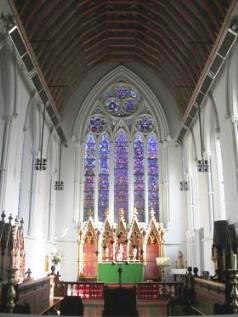
In 1847, his father invited him to return home to France for a visit but as Edward recalled, the friction between them continued:
Needless to say everything was pleasant at first. But whether being at a critical age, I was not ill but irritable and self important. I was more apt than usual to take up any small argument or contradiction I met with. It was difficult in some respects to meet my father. But I consider his treatment was ill calculated to produce a cure: in the result I was shamefully treated. Glad to escape, for it almost came to that. I reserved all remarks till my return to London, when I took the occasion in a letter to inform my father that with regard to his behaviour to me I would “reprobate it to the last day of my existence” and so I have and so I will, notwithstanding his disclaimer. I returned but once again to the home roof at long last, when nature appealed for a last call, and my father was taken hence 19 Feb 1857.
While working in Camberwell, Edward met his first wife Mary Ann Martha Leigh Boyles. Mary Ann was born in Truro, Cornwall in 1828, the only child of Thomas Boyles, a Master Mariner, and his wife Martha Yewens. Her father perished at sea years before and Mary Ann lived with her widowed mother in Camberwell.
Edward and Mary Ann met at St Giles when he sat next to her in church. They began to spend more time together and as Edward recalled, ‘her company became the chief pleasure of my spare hours’ and almost 50 years later, Edward remembered his first wife in the most loving terms:
Her face was beauty itself, strong decision (on occasion) marked it softened and toned down by the loveliest eyes of deep blue. Dark hair crowned her head which by its shape well became the plaited coronet which she was fond of placing over her forehead. A wealth of dark hair was her gift and ornament worn in wide bandeaus by the side of the face. A face oval in shape of tenderest complexion, and a throat which a swan might rival in whiteness and grace.
Despite his father’s opposition, Edward and Mary Ann were engaged in 1850 – ‘we were engaged; she loved me with her whole heart as I loved her’. In an attempt to improve his professional situation, Edward resigned from his employment with Mr. Stow and took a new position as an assistant to an architect, T.C. Robinson, in Wolverhampton but after only eight months, he returned to London to work as an Assistant in the office of the Architect of the South Eastern Railway, Mr. W. Tress, in Finsbury Circus at a salary of £100 a year. But tales of the riches to be made in the gold fields of Australia proved too tempting to Edward and his co-workers and they began to plan to leave their jobs and make their fortune prospecting for gold. Despite the ongoing conflict between Edward and his father, he agreed to send him £50 to pay for his passage to Australia but it is not known whether he supported Edward or saw this as an opportunity to end the relationship between his son and Mary Ann.
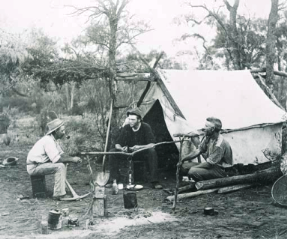
Edward boarded the Panama from St Katherine Docks on 28 June 1852 and sailed down the Thames to Gravesend, along the coast to Dover and then across the Channel to the Bay of Biscay; from there, the ship continued down the west coast of Africa and across the Indian Ocean to Australia. The passengers disembarked at Williamstown, south of Melbourne, and Edward made his way on foot to Forest Creek near Bendigo where he spent one season in the mines before returning to Melbourne for the winter. Although he did find success in one mine, he arrived back in Melbourne with approximately the same amount of money as when he left.
He quickly obtained a position as an Architect’s assistant in Melbourne but left three months later to return for a second season in the diggings. He earned £45 prospecting for gold but despite an offer to manage a dry goods store, he set his mind on returning to England and after booking his return passage, he arrived back in England on 11 June 1854. He took several positions including a book-keeper and Architect’s assistant before settling in a position with Mr. Dobson, an architect on Mile End Road. Edward finally married Mary Ann at St Giles, Camberwell on 5 May 1855 and after their marriage, they took lodgings at 349 Albany Road in Camberwell occupying a sitting room and bedroom on the ground floor. Much to Edward's dismay, his mother-in-law Martha also took rooms in the house.
On 21 January 1856, their first child, Mary Ann Martha Leigh, was born ‘somewhat prematurely’ as noted in her father’s diary. Sadly, his wife Mary Ann died eight days later of puerperal fever and was buried in a common grave at Nunhead Cemetery in Peckham. Martha Boyles was never in favour of her daughter’s marriage and following her death, Martha wanted nothing more to do with Edward or sadly, her granddaughter. Unable to care for his infant daughter, Edward was forced to place her in the care of a succession of nurses and his memoirs recount the struggle he had dealing with his grief, finding and paying for suitable care and even bonding with his daughter:
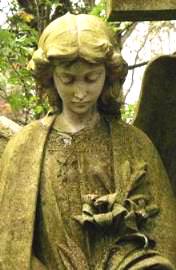
I fear me I did not show that tenderness always nor that deep, deep interest I should have displayed towards the motherless child, the living representative of its mother on earth, the living relic of her I shall ever carry in my mind as the dearest, tenderest friend I ever possessed, and who loved me, loved me for myself and appreciated me most flatteringly to my self love, if I had much.
Edward travelled to Jersey in July after hearing of his father’s poor health. But even the circumstances of the visit did not result in a tempering of their relationship: ‘found my father anything but well, querulous and rather exacting, perhaps on account of his weak state; my sisters some of them and Mrs. M. I fear too, getting a little impatient.’
In mid October, his daughter’s health deteriorated and on 1 November 1856, Mary Ann Martha Leigh, aged only 9 months, died while in the care of a nurse maid. With help from his sisters, Harriet and Charlotte, Edward purchased a private grave at Nunhead Cemetery and had his wife moved from the common grave and his little daughter buried with her mother.
Three months after the death of his daughter, Edward’s father died in on the island of Jersey on 19 February 1857. He received a legacy of £100 from his father’s estate and used the money towards the purchase a home for £300 from his friends the Hardys, at 25 Brunswick Terrace off Camberwell Road. He lived on the lower floor while renting out the upper floors to the McDonald family. But despite appearances, Edward was not ready to settle and in 1858, he decided to emigrate to the colony of Vancouver Island on the west coast of Canada. He sold his home and possessions and borrowed £70 from his sister, Charlotte, to pay for the passage.
Edward travelled by train to Liverpool where he boarded the City of Washington steamer for the first leg of his journey; he stopped in New York and transferred to the Moses Taylor for the voyage on to Panama but as the canal had not yet been built, Edward had to travel by train across Panama before boarding the Sonora to San Francisco. A fellow passenger, who had a ticket which guaranteed him passage to Victoria, decided to stay in San Francisco so Edward purchased the ticket from him for half the usual cost of $25. The steamer landed at Esquimalt harbour on 12 October 1858 and the passengers had to walk the 3 ½ miles to Victoria.
When he arrived he sought out Donald Fraser ‘whose able letters I was indebted for all the information I possessed of the new Dorado. I told Mr. Fraser whom I found a very conversable pleasant gentleman, that to him I was indebted for my presence here and probably much to his surprise, asked what I had better do. I was advised to go to the mines.’ Edward’s reminiscences don’t contain any information on how he came to know or write to Donald Fraser but he took his advice and began his journey to the Caribou gold fields.
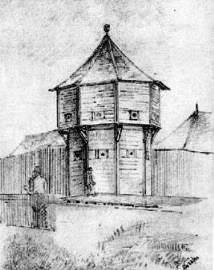
c. 1858
He travelled to the mainland by boat with two fellow passengers but they soon split up after a disagreement and Edward recounted what happened after his travelling companions left:
But my adventures were not over. Soon after I was left to myself some Indians (they are ubiquitous) arrived. They proved to be father and son and wife. They proved to be friendly & Quamichan. They quickly made a fire. Indians are very partial to bark fires in any case: there is much heat and very little smoke. They will squat quite close to a bark fires, perhaps in the open air, perhaps in their hovels - “a small fire and close to it, better than a large fire no come near” they say. Well, we made some bread rolls and boiled some potatoes of which I had a few; the young woman I noticed had very shapely hands and probably they were all as clean as I was, not having worked for two days. But as ill-luck would have it, more Indians were seen in the distance. We might have escaped their observation: I cannot say. But the demon or unrest or rashness urged me to call them which I did with, the Australian coo-ee, which sound carries a great distance. I rather think my Indians were opposed to it. To my disagreeable surprise, 17 Indians little and big made their appearance, cooked what remained of my potatoes without the least apology or stint, they appeared to be eating all night.
The next day ‘one of them rather ostentatiously cleaned his shot-gun before me and reloaded it and stood over me while the others without apology or request appropriated all I had, even to my silver keyed flute by Monzann, a gift from my father. They very considerately returned me the case and my music!’ He got as far as Fort Langley before he came to the conclusion that the mines were not for him: ‘By this time I was satisfied they had thoroughly misconceived the conditions of mining in B. Columbia. With scant clothing and leaky boots, so far as I was concerned, the matter was impracticable.’
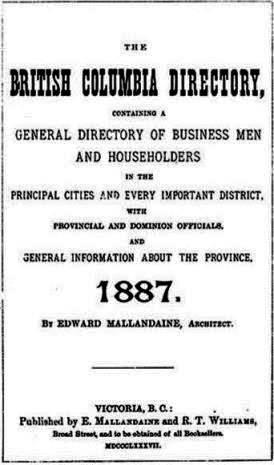
He returned to Victoria and obtained a teaching position at a private school operated by Mr. Silversmith and shortly after, Mr. Silversmith proposed the idea to publish a city directory -
At Mr. Silversmith’s suggestion, we agreed to get up a Directory of Victoria and the Province! I was to do the literary part, including all the names; he (Mr. S.) was to canvass for cards and advertisements. The work progressed and assumed shape; we decided to add illustrations on behalf of those tradesmen or store keepers the more ambitious term, who were enterprising enough to launch into a little expenditure. Twelve sketches were prepared by me of buildings more or less comely and duly engraved, the blocks which formed part of the charge to us, being duly handed to the advertisers, and capable of serving for bill-heads etc.
Edward eventually purchased the Victoria Select School from Mr. Silversmith for $250 and later opened new premises on Broad Street, increased enrolment to 30 students and expanded it to include the city’s first night school for adults. He operated the school for two years while attempting to raise the capital necessary to publish the directory.
The First Victoria Directory was finally published in 1860 and contained a list of both residents and businesses. He published four more directories between 1868-1874 but none were terribly profitable and he eventually gave up his school and took a position in a government school. In 1863, he opened his first office on the upper floor of the Moore’s Building on Yates Street and began working as an architect. One of his first commissions was the design of a three storey brick and stone building on Store Street but there was little work for architects in Victoria and Edward had to again seek alternate employment. Against his better judgement, he accepted a position as a government agent and was responsible for collecting road taxes and other debts for the districts of Saanich, Metchosin and Esquimalt and although the position did not offer a salary, he was paid a commission of 10% of all monies collected.
In 1865, Edward met Louisa Townsend at St John’s Church where she sang in the choir. Later in life, Louisa recounted that Edward said ‘he fell in love with my wonderful hair’ but Edward was more reserved in his reminiscences when he wrote ‘I found Miss Townsend amiable, industrious and resourceful.’ Whatever the attraction, Edward proposed in March 1866 and Louisa accepted.